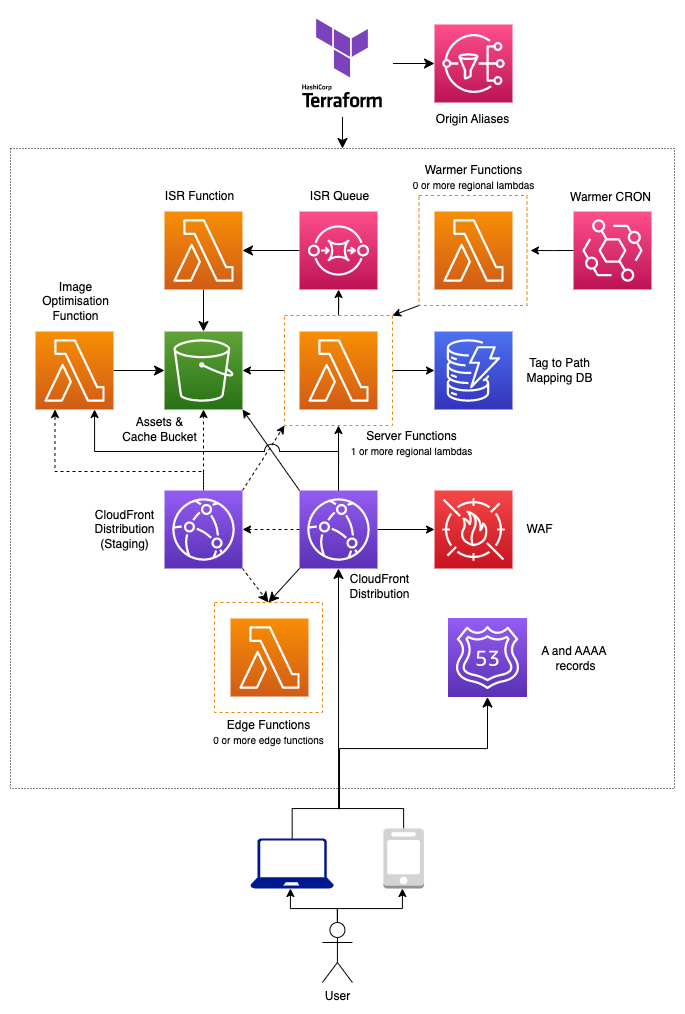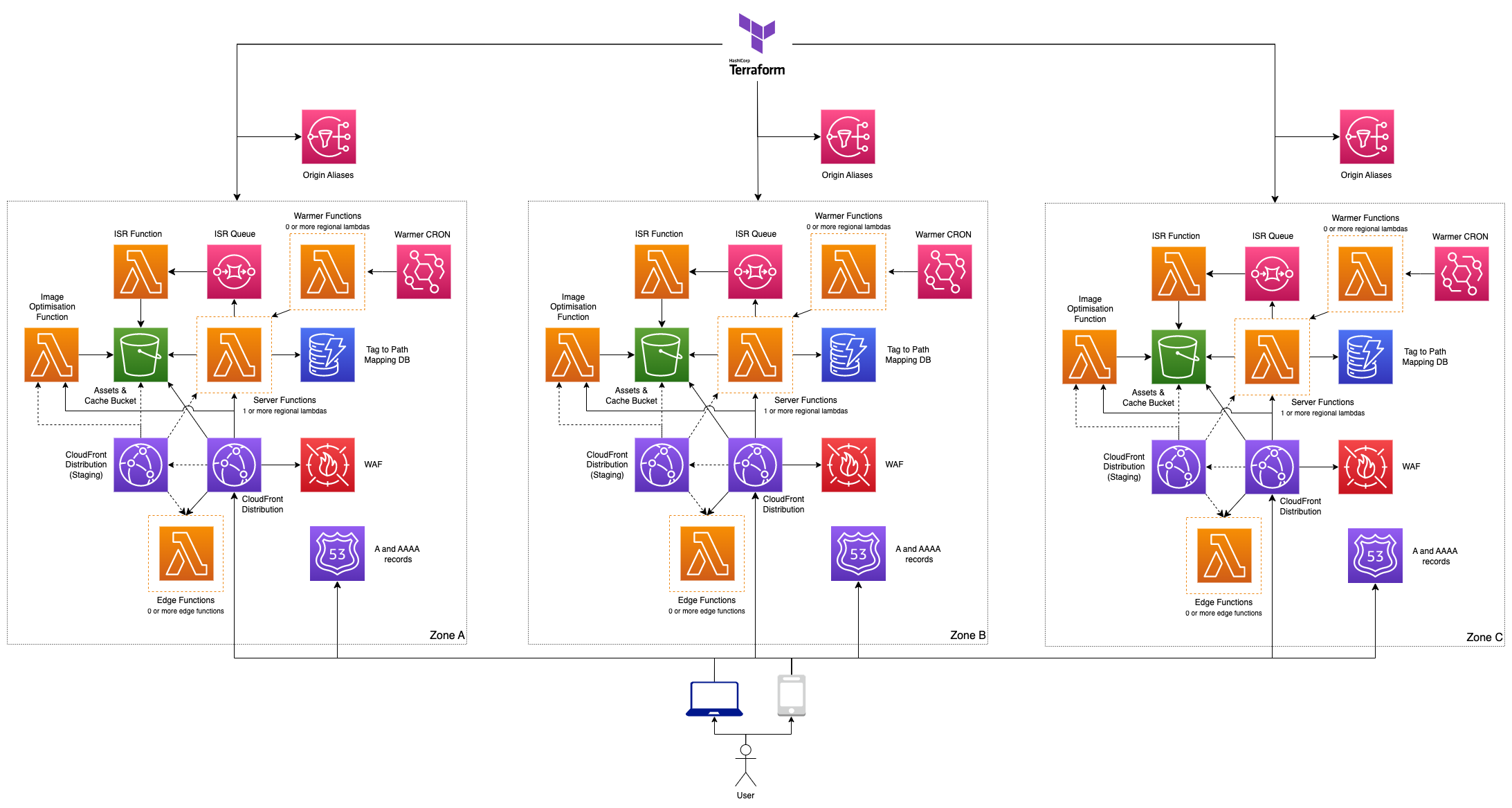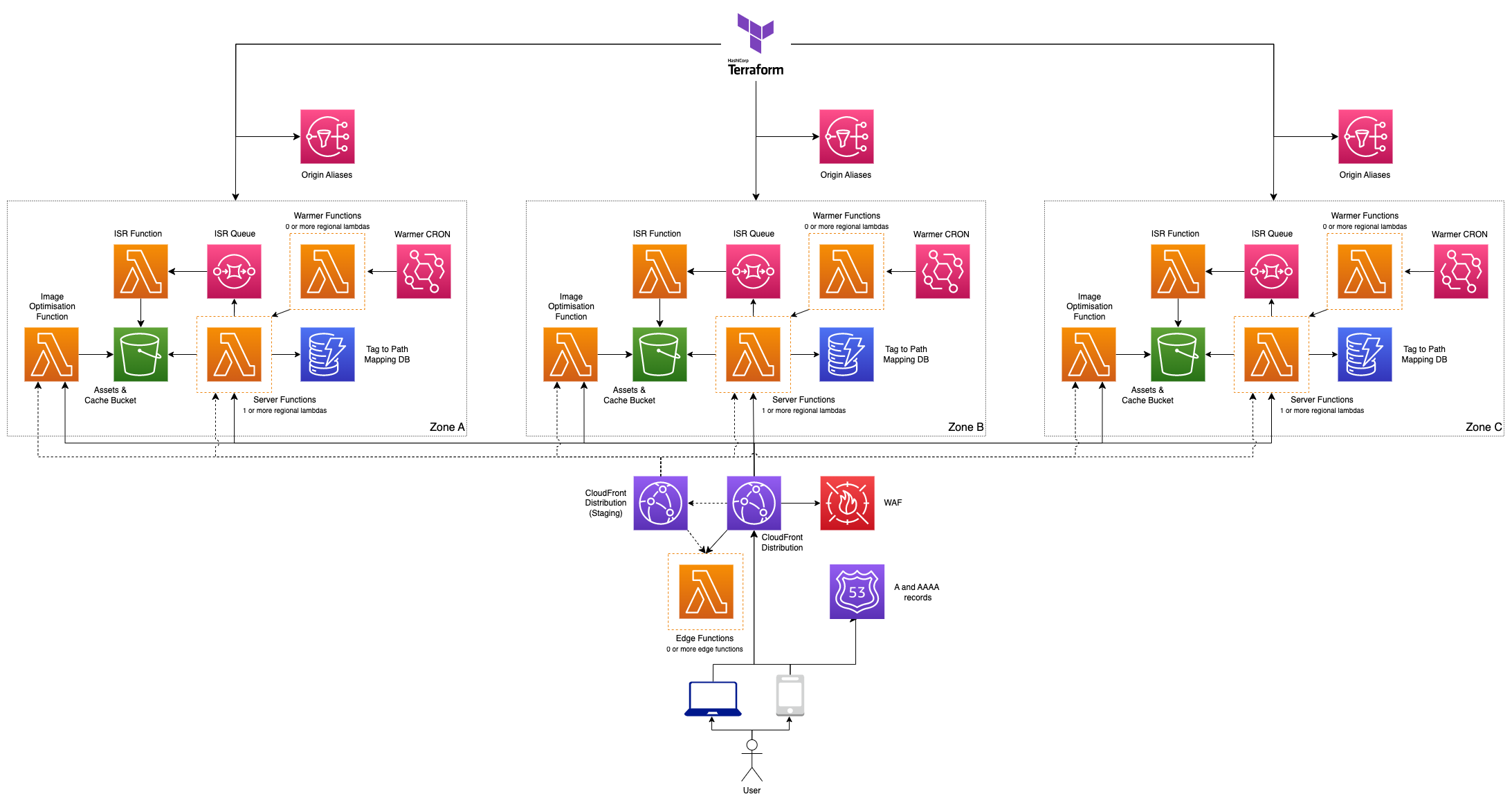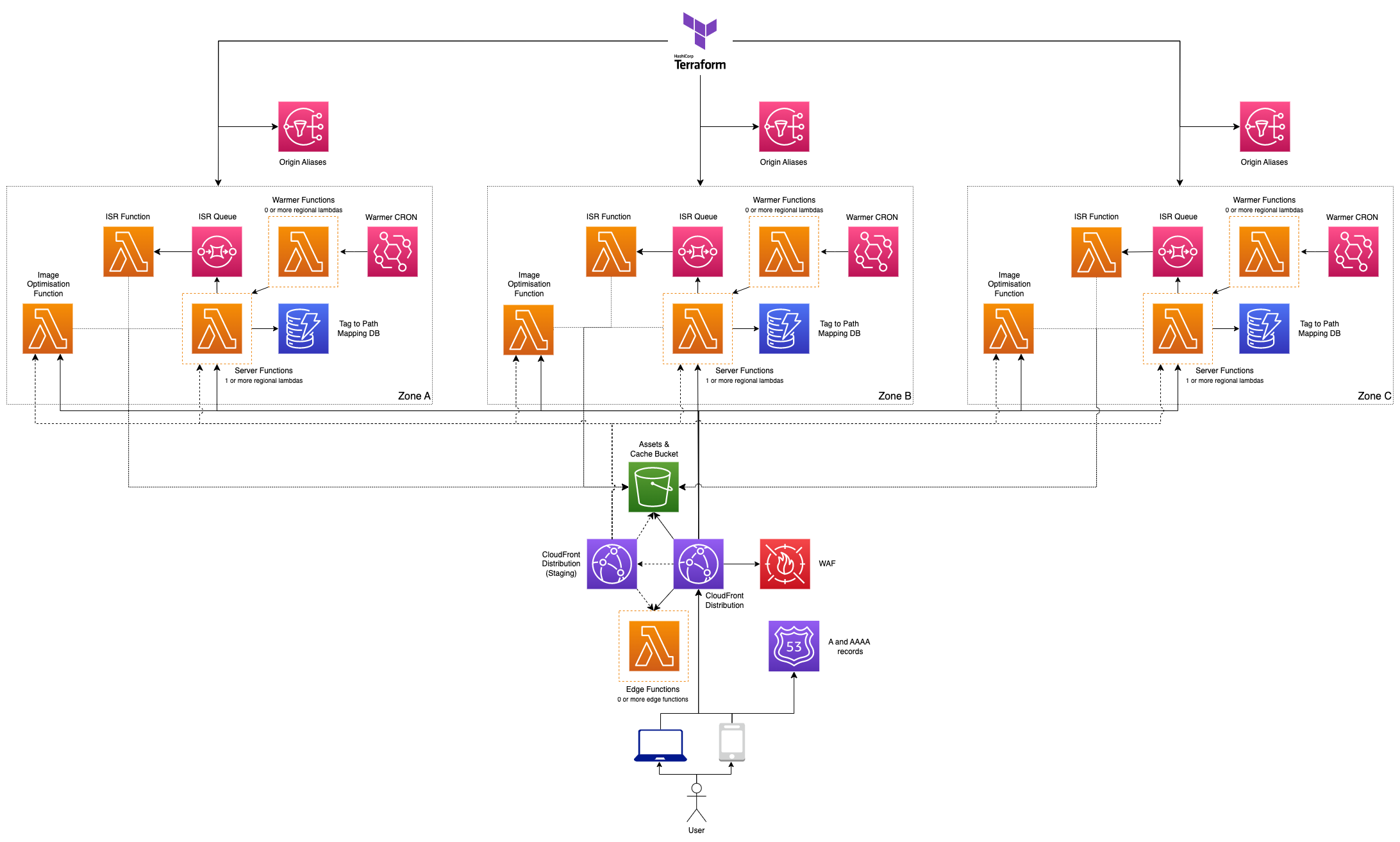This module deploys a next.js website using Open Next to AWS utilising lambda, S3 and CloudFront.
This repo contains modules that let you build single-zone or multi-zone websites using Open Next v1 (legacy module - this is deprecated), v2 and v3.
Version 3 of the module supports many of the features released as part of Open Next v2 and V3, including:
- Support for function splitting
- Support for external middleware (Only Lambda@edge is supported)
- Support for
open-next.output.jsonconfiguration file - Support for server actions
- Support for ISR revalidation
- Support for Image Optimisation
NOTE: Open Next v3 introduced additional deployment targets. This module only supports hosting resources in lambda and lambda@edge; running resources on Cloudflare, ECS, etc., is not supported.
Where possible, the modules try to give you as many configuration options as possible; however, the module won't be able to cater to all use cases. For the majority of components, you can curate your bespoke resources in Terraform, i.e. WAF, CloudFront distribution, etc., and pass the ARN of the resource to the module to use.
Some additional features of the module include:
- CloudFront continuous deployments
- Lambda function URLs with IAM Auth
- using lambda@edge auth function - AWS Blog - https://aws.amazon.com/blogs/compute/protecting-an-aws-lambda-function-url-with-amazon-cloudfront-and-lambdaedge/
- using Origin Access Control - AWS Blog - https://aws.amazon.com/blogs/networking-and-content-delivery/secure-your-lambda-function-urls-using-amazon-cloudfront-origin-access-control/
- WAF
- Includes AWS recommended rules (AWSManagedRulesAmazonIpReputationList, AWSManagedRulesCommonRuleSet & AWSManagedRulesKnownBadInputsRuleSet)
- Configure multiple IP rate-based rules
- Configure SQL injection rules
- Configure account takeover protection rules
- Configure account creation fraud prevention rules
- Configure basic auth
- This is inspired by Vercel's password-protected deployment feature - https://vercel.com/guides/how-do-i-add-password-protection-to-my-vercel-deployment
- Credit to Shinji Nakamatu for this idea - https://dev.to/snaka/implementing-secure-access-control-using-aws-waf-with-ip-address-and-basic-authentication-45hn
- Custom rules (with custom response bodies), i.e. add a maintenance page to take the website offline when maintenance is taking place
- Configure default action (with custom response bodies)
- Custom Error Pages
And more
If you plan to use a single-zone deployment model only, please use the tf-aws-open-next-zone module. If you manage multiple zones in the same terraform state, please use the tf-aws-open-next-multi-zone module. Installation and module documentation can be found in the corresponding folders.
Note: These modules use multiple bash scripts to delete data, upload data and mutate resources outside of Terraform. This prevents Terraform from removing resources when they have changed and allows the staging distribution functionality to work correctly. You must have bash and the AWS CLI available. The CLI must be configured to use the same credentials or environment variables as the default AWS provider for this functionality to work correctly.
The module is available in the Terraform registry
The v1, also known as the legacy module, has been kept to ensure that you can continue to use the module and receive some updates (will be determined on a case-by-case basis); you may want to use this instead of adopting the newer features. To use the legacy module, please add the following code. The existing variables and inputs have been retained.
module "legacy" {
source = "RJPearson94/open-next/aws//modules/legacy"
version = ">= 2.0.0, < 3.0.0"
...
}When upgrading to v2 of the module, it is recommended that you redeploy your application into a new Terraform state and then shift traffic over due to the number of changes compared to the legacy module. If this is not possible, you can attempt to import the existing resources into your terraform state. See the terraform docs for more information
The module has been made backwards compatible with 2.x where possible.
For open next v3, the module will read the open-next.output.json file in the .open-next directory to determine the edge and server functions that need to be configured, as well as any default configuration, e.g., streaming.
NOTE: Deprecated fields have been removed. If you use one of the following values, you will need to modify your Terraform/ Terragrunt configuration
- The
EDGE_LAMBDAbackend deployment type is no longer supported for server function. In open next v3, this has been moved into edge functions instead [BREAKING CHANGE] aws_lambda_permission.server_function_url_permissionandaws_lambda_permission.image_optimisation_function_url_permissionhave been merged into a list ofaws_lambda_permission.function_url_permissionresources in thetf-aws-open-next-multi-zonemodule. You can either let the resources re-create or update the references using either move config, import block or import command [BREAKING CHANGE]- CloudFront cache policy ARN - you must now set the CloudFront Cache Policy ID
- Auth function CloudFront log group - this configuration had no effect, so it has been removed
- Lambda Logging configuration (for regional lambda's only) [NEW FEATURE]
- Additional configuration of CloudWatch log groups, including having a log group for all regional functions in a zone [NEW FEATURE]
If you are still using open next v2.x, you can set the open_next_version variable to v2.x.x (the default value). If you upgrade to Open Next v3.x, please set the open_next_version variable to v3.x.x.
If you want to migrate from Open Next v2 to v3, see the migration guide, which the Open Next team created.
Below are diagrams of the possible architecture combinations that can configured using v2 of this module. For each of the architectures, the following components are optional:
- Route 53 (A and AAAA records)
- WAF
- Staging Distribution
- Warmer function
- Image Optimisation function
- Tag to Path Mapping DB
data "aws_caller_identity" "current" {}
module "single_zone" {
source = "RJPearson94/open-next/aws//modules/tf-aws-open-next-zone"
version = ">= 2.0.0, < 3.0.0"
prefix = "open-next-${data.aws_caller_identity.current.account_id}"
folder_path = "./.open-next"
}terraform {
source = "tfr://registry.terraform.io/RJPearson94/open-next/aws//modules/tf-aws-open-next-zone?version=v3.1.0"
include_in_copy = ["./.open-next"]
}
inputs = {
prefix = "open-next-${get_aws_account_id()}"
folder_path = "./.open-next"
}data "aws_caller_identity" "current" {}
module "independent_zones" {
source = "RJPearson94/open-next/aws//modules/tf-aws-open-next-multi-zone"
version = ">= 2.0.0, < 3.0.0"
prefix = "open-next-ind-${data.aws_caller_identity.current.account_id}"
deployment = "INDEPENDENT_ZONES"
zones = [{
root = true
name = "home"
folder_path = "./home/.open-next"
},{
root = false
name = "docs"
folder_path = "./docs/.open-next"
}]
}terraform {
source = "tfr://registry.terraform.io/RJPearson94/open-next/aws//modules/tf-aws-open-next-multi-zone?version=v3.1.0"
include_in_copy = ["./docs/.open-next", "./home/.open-next"]
}
inputs = {
prefix = "open-next-ind-${get_aws_account_id()}"
deployment = "INDEPENDENT_ZONES"
zones = [{
root = true
name = "home"
folder_path = "./home/.open-next"
},{
root = false
name = "docs"
folder_path = "./docs/.open-next"
}]
}Note: If you use tools like Terragrunt or CDKTF, you can use the Single Zone module to deploy each zone into its own terraform state
data "aws_caller_identity" "current" {}
module "shared_distribution" {
source = "RJPearson94/open-next/aws//modules/tf-aws-open-next-multi-zone"
version = ">= 2.0.0, < 3.0.0"
prefix = "open-next-sd-${data.aws_caller_identity.current.account_id}"
deployment = "SHARED_DISTRIBUTION"
zones = [{
root = true
name = "home"
folder_path = "./home/.open-next"
},{
root = false
name = "docs"
folder_path = "./docs/.open-next"
}]
}terraform {
source = "tfr://registry.terraform.io/RJPearson94/open-next/aws//modules/tf-aws-open-next-multi-zone?version=v3.1.0"
include_in_copy = ["./docs/.open-next", "./home/.open-next"]
}
inputs = {
prefix = "open-next-sd-${get_aws_account_id()}"
deployment = "SHARED_DISTRIBUTION"
zones = [{
root = true
name = "home"
folder_path = "./home/.open-next"
},{
root = false
name = "docs"
folder_path = "./docs/.open-next"
}]
}data "aws_caller_identity" "current" {}
module "shared_distribution_and_bucket" {
source = "RJPearson94/open-next/aws//modules/tf-aws-open-next-multi-zone"
version = ">= 2.0.0, < 3.0.0"
prefix = "open-next-sb-${data.aws_caller_identity.current.account_id}"
deployment = "SHARED_DISTRIBUTION_AND_BUCKET"
zones = [{
root = true
name = "home"
folder_path = "./home/.open-next"
},{
root = false
name = "docs"
folder_path = "./docs/.open-next"
}]
}terraform {
source = "tfr://registry.terraform.io/RJPearson94/open-next/aws//modules/tf-aws-open-next-multi-zone?version=2.0.2"
include_in_copy = ["./docs/.open-next", "./home/.open-next"]
}
inputs = {
prefix = "open-next-sb-${get_aws_account_id()}"
deployment = "SHARED_DISTRIBUTION_AND_BUCKET"
zones = [{
root = true
name = "home"
folder_path = "./home/.open-next"
},{
root = false
name = "docs"
folder_path = "./docs/.open-next"
}]
}For information on managing custom domains, see the domain config documentation
The examples have been moved to a separate repository to reduce the amount of code that Terraform downloads. You can find them at RJPearson94/terraform-aws-open-next-examples repo



